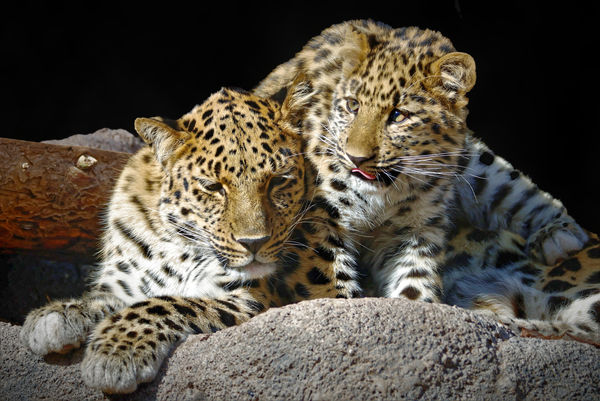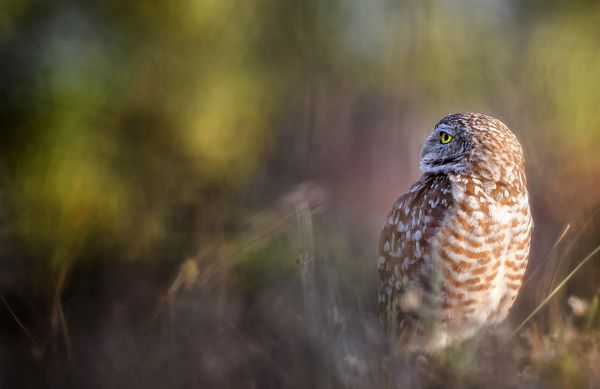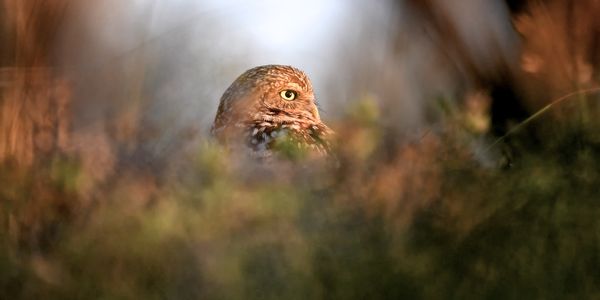What can you hide?
Nov 8, 2018 08:57:13 #
CPR wrote:
Removing objects, be they a water spot or Uncle Harry, from a photo takes a pixel level tool like Photoshop. Once you get comfortable with Photoshop you may rarely go back to Lightroom.
The ops question was about how to make something disappear with the camera, such as shooting through a fence and the fence magically disappears.
Nov 8, 2018 09:06:16 #
Nov 8, 2018 09:24:56 #
mwsilvers
Loc: Central New Jersey
bgrn wrote:
After going to the zoo last week and posting a few... (show quote)
I was able to remove the background fence and some other background artifacts and took the liberty of brightening the image a bit and adding a little micro contrast. It was done quick and dirty and the results would have been cleaner if I have taken more time. For me post processing is much more about adjusting the exposure than removing objectionable objects.
Nov 8, 2018 13:00:08 #
What's the largest item I've hidden by focusing through it? A coin (US quarter) taped over the 50 cent piece sized objective lens of a K&E surveyors transit as a prank. By focusing through it I could make it like it wasn't there. The image was dark but usable. I continued working as if nothing was wrong. It drove the joker who had placed the quarter there up the wall. I could still see through the scope and the crosshairs were still visible. So the largest solid image that I've focused though is a US quarter. I've often resorted to placing my lens hood right onto a chainlink fence in order to hide the fence. It works well except with my ultra wide angle at small apertures.
Nov 9, 2018 14:40:30 #
gray_ghost2
Loc: Antelope, (Sac) Ca.
I've never seen a Lion in the snow. Was that in natural surroundings or in a zoo?
Nov 9, 2018 22:39:33 #
gray_ghost2 wrote:
I've never seen a Lion in the snow. Was that in natural surroundings or in a zoo?
Please use ‘quote reply’ so readers know who you are responding to.
Where in this thread is there a lion in the snow?
If your response was to the original poster, in his first sentence he says “After going to the zoo last week“.
Nov 9, 2018 22:53:05 #
mwsilvers
Loc: Central New Jersey
gray_ghost2 wrote:
I've never seen a Lion in the snow. Was that in natural surroundings or in a zoo?
I believe those are leopards, not lions.
Nov 10, 2018 05:40:35 #
bgrn wrote:
Thanks, I understand the principles as to why, I was just curious as to how large of an object people have been able to hide outside of the focal range. I do like the idea of this AP. i'm going to have to check it out.
Great photo.
How big an object with "vanish" depends on how out of focus it is, and much it contrasts
with the rest of the scene.
The chain link fence is still in the picture. It's just very, very blurry and superimposed
on the entire scene. It's still there, degrading your image a tiny bit,
Not much, because the fence was kind of a neutral gray color, and fairly thin wire.
Had it been thicker or painted black or white, it would degrade the image more and
be more noticable.
If you took another exposure without the chain-link fence....you'd be a leopard's dinner.
But if you somehow didn't get eaten, you'd get a slightly sharper picture with slightly more
contrast. Whether or not the difference would be noticable I can't say.
Whether or not one can see defects in an image depends on its subject and how
the image is displayed: the size, dynamic range, etc. A good analogy is: how much
static can there be in an AM radio signal before it becomes noticable? Obviously, it
depends on the program (quiet or noisy) and whether you are listening though a tinny
speaker or high-quality headphones.
In this case, the noise isn't static, but had a regular pattern. In physicist David Bohm's
term, it is an "implicate order" in the image. I don't know if it could ever be made
visible in this photo, but a pattern of light and dark areas would probably show up
if a statistical test designed to look for it was run on the image file. (Another kind of
implicate order is a hologram. In that case, the image is recoverable.)
Anyway, getting back to how images are displayed: lots of images look great on the
camera's display don't look good on a computer monitor. And lots of photos that look
good on the computer monitor don't look good when printed at 24" x 16" Resolution
is a big factor, but there are others: each device or medium has a different dyanmic range.
And as I said, the subject matters. Take distortion for example How do you tell if a photo
of a octopus has distoration?

Finally, human beings notice some kinds of image degredation much more than others.
Impressionist painters exploited this fact: painting precise detail only where it was
necessary. In George Seurat's potillist paintings for example, there are lines only
where there need to be (e.g., the edges of a boat's sails, or of a tree trunk). Elsewhere,
there are only dots of color (rather like a color lithograph, but much larger).
https://upload.wikimedia.org/wikipedia/commons/9/96/Georges_Seurat_026.jpg
There is some similarity between how Seurat painted and what the "sharpen" filter
does. But there are two huge differences: (1) the shapren filer ia an algorithm not a
painter: it may create edges where tehre aren't supposed to be anay. And (2) a
painting does not start out as a photograph: an optical image of a real scene.
There is a vast amount of lighting informatoin in any real scene. Global changes
(such as lighten or darken) will still look natural. But local changes -- unless done
with the lighting knowledge of a painter--risk crearting "impossible lighting" that
won't look real. Lighten the shadows under a gree too much, and it will look like
someone is under there with a flashlight.

So it's best to be quite conservative about local changes: small ones only, and never
with sharp edges. Remember: "invisble" is relative: painters and some photographers
see things in an image that most people would miss. (In the old days, instructors would
say that if they could spot your dodging and burning, it was too much.)
Anybodywho know enough to start moving light around can make a lot more money
as a painter than as a photographer. How much do painters know about light?
http://boydgavin.com/wp-content/uploads/2016/07/Trucks-and-Mud-3.jpg
https://efgprivatecollections.com/wp-content/uploads/2016/03/GavinSpilledCrayonsImage.jpg
Nov 10, 2018 07:49:50 #
In wildlife its not always possible to get a clear shoot of the subject, so you need to learn to embrace the clutter. If you keep your lens WIDE OPEN and focus only on the subject the clutter can enhance the subject. When I first shot Burrowing Owls I looked for good clean shots. Nice, but Extremely Boring and Average. Then I started to shoot on their level and embrace the clutter. Takes longer, but not without rewards.
Nov 14, 2018 00:26:11 #
User ID wrote:
2.721000 million miles around, give
or take a few .....
And thaz just during the daytime. At
night, I can defocus whole galaxies !
or take a few .....
And thaz just during the daytime. At
night, I can defocus whole galaxies !
How did you do that? Use a stack of nd filters? That's awesome.
If you want to reply, then register here. Registration is free and your account is created instantly, so you can post right away.








